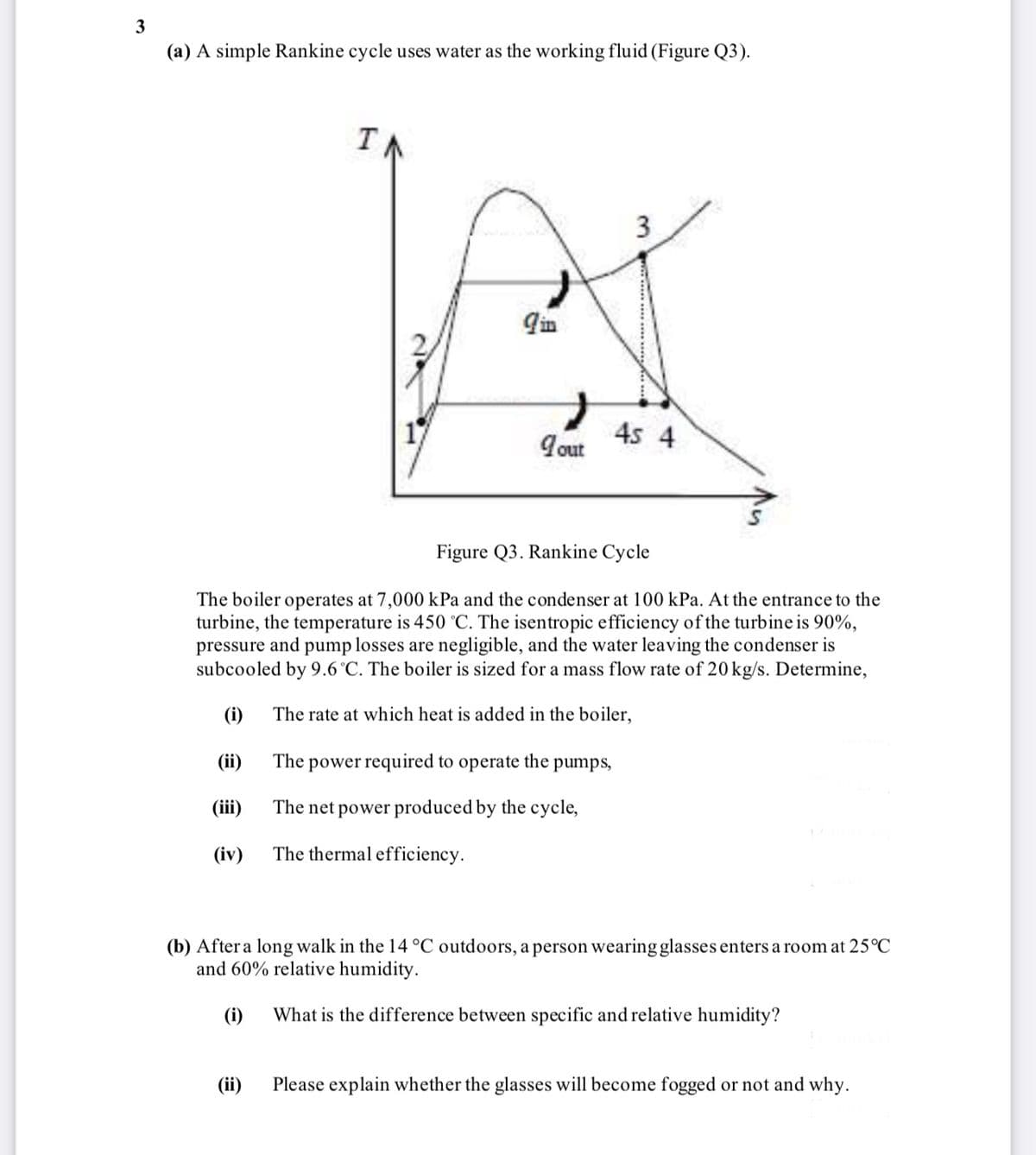(a) A simple Rankine cycle uses water as the working fluid (Figure Q3). IN gin 4s 4 gout Figure Q3. Rankine Cycle The boiler operates at 7,000 kPa and the condenser at 100 kPa. At the entrance to the turbine, the temperature is 450 °C. The isentropic efficiency of the turbine is 90%, pressure and pump losses are negligible, and the water leaving the condenser is subcooled by 9.6°C. The boiler is sized for a mass flow rate of 20 kg/s. Determine, (i) The rate at which heat is added in the boiler, The power required to operate the pumps, The net power produced by the cycle, (ii) (iii)
(a) A simple Rankine cycle uses water as the working fluid (Figure Q3). IN gin 4s 4 gout Figure Q3. Rankine Cycle The boiler operates at 7,000 kPa and the condenser at 100 kPa. At the entrance to the turbine, the temperature is 450 °C. The isentropic efficiency of the turbine is 90%, pressure and pump losses are negligible, and the water leaving the condenser is subcooled by 9.6°C. The boiler is sized for a mass flow rate of 20 kg/s. Determine, (i) The rate at which heat is added in the boiler, The power required to operate the pumps, The net power produced by the cycle, (ii) (iii)
Elements Of Electromagnetics
7th Edition
ISBN:9780190698614
Author:Sadiku, Matthew N. O.
Publisher:Sadiku, Matthew N. O.
ChapterMA: Math Assessment
Section: Chapter Questions
Problem 1.1MA
Related questions
Question

Transcribed Image Text:3
(a) A simple Rankine cycle uses water as the working fluid (Figure Q3).
IA
9 in
4s 4
gout
Figure Q3. Rankine Cycle
The boiler operates at 7,000 kPa and the condenser at 100 kPa. At the entrance to the
turbine, the temperature is 450 °C. The isentropic efficiency of the turbine is 90%,
pressure and pump losses are negligible, and the water leaving the condenser is
subcooled by 9.6 °C. The boiler is sized for a mass flow rate of 20 kg/s. Determine,
(i)
The rate at which heat is added in the boiler,
(ii)
The power required to operate the pumps,
(iii)
The net power produced by the cycle,
(iv)
The thermal efficiency.
(b) After a long walk in the 14 °C outdoors, a person wearing glasses enters a room at 25°C
and 60% relative humidity.
(i)
What is the difference between specific and relative humidity?
(ii)
Please explain whether the glasses will become fogged or not and why.
An
Expert Solution
This question has been solved!
Explore an expertly crafted, step-by-step solution for a thorough understanding of key concepts.
Step by step
Solved in 3 steps with 3 images

Knowledge Booster
Learn more about
Need a deep-dive on the concept behind this application? Look no further. Learn more about this topic, mechanical-engineering and related others by exploring similar questions and additional content below.Recommended textbooks for you

Elements Of Electromagnetics
Mechanical Engineering
ISBN:
9780190698614
Author:
Sadiku, Matthew N. O.
Publisher:
Oxford University Press

Mechanics of Materials (10th Edition)
Mechanical Engineering
ISBN:
9780134319650
Author:
Russell C. Hibbeler
Publisher:
PEARSON

Thermodynamics: An Engineering Approach
Mechanical Engineering
ISBN:
9781259822674
Author:
Yunus A. Cengel Dr., Michael A. Boles
Publisher:
McGraw-Hill Education

Elements Of Electromagnetics
Mechanical Engineering
ISBN:
9780190698614
Author:
Sadiku, Matthew N. O.
Publisher:
Oxford University Press

Mechanics of Materials (10th Edition)
Mechanical Engineering
ISBN:
9780134319650
Author:
Russell C. Hibbeler
Publisher:
PEARSON

Thermodynamics: An Engineering Approach
Mechanical Engineering
ISBN:
9781259822674
Author:
Yunus A. Cengel Dr., Michael A. Boles
Publisher:
McGraw-Hill Education

Control Systems Engineering
Mechanical Engineering
ISBN:
9781118170519
Author:
Norman S. Nise
Publisher:
WILEY

Mechanics of Materials (MindTap Course List)
Mechanical Engineering
ISBN:
9781337093347
Author:
Barry J. Goodno, James M. Gere
Publisher:
Cengage Learning

Engineering Mechanics: Statics
Mechanical Engineering
ISBN:
9781118807330
Author:
James L. Meriam, L. G. Kraige, J. N. Bolton
Publisher:
WILEY